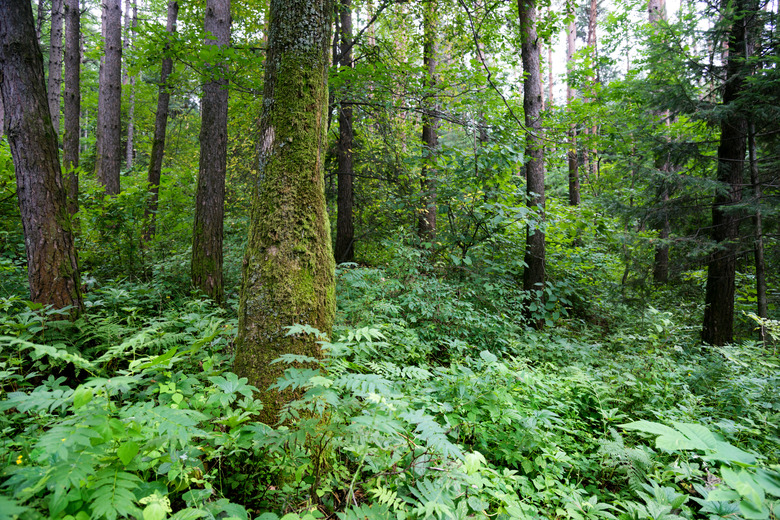Plant-Eating Animals In The Rain Forest
Rain forests, which cover approximately 6 percent of the Earth's surface, harbor a variety of herbivores, which are animals that subsist solely on vegetation. Known also as primary consumers, the majority of herbivores in the tropical rain forest are mammals. Other rain forest species are omnivorous, which means they feed on both plant and animal matter.
Ungulates
Ungulates
Many rain forest-dwelling ungulates – animals with hooves – are herbivores, including the tapir of South America, which consumes herbaceous vegetation and fruit, especially bananas. Able swimmers, tapirs also feed on aquatic plants. The rain forests of Latin America are home also to the pig-like collard peccary, which eats tubers and bulbs.
The okapi – the giraffe's only living relative – inhabits the tropical rain forests of the Democratic Republic of Congo in Africa. Okapis feed on buds and young leaves. Two types of antelopes or duikers – the little blue duiker and the yellow-backed duiker – dwell in the African rain forests. The former is found in Kenya, Tanzania and Uganda; the latter is more widespread. They mainly subsist on leaves, fruits and seeds.
Rodents
Rodents
The world's largest rodent, the capybara, eats grasses and aquatic plants in the rain forests of South America, which are also home to agoutis, rodents that feed on fallen fruits and nuts. A keen auditory sense allows agoutis to hear fruit hitting the ground; sharp incisor teeth make them the only animals capable of opening Brazilian nuts.
Acouchis, which are related to agoutis, feed on grass, roots, stems, leaves and fruit. They live in the rain forests of Colombia, Ecuador, Peru and Brazil. Porcupines, found in a variety of habitats including rain forests, are also herbivores in the Amazon rain forest.
Primates
Primates
A few rain forest-dwelling primates are herbivores, including gorillas. Found in the equatorial rain forests of Africa, gorillas feed on all plant parts. The rain forests of western Africa are also home to the omnivorous mandrill, the largest monkey. Mandrills' diets include seeds, roots, nuts and fruit. Moreover, most lemurs, a type of primate endemic to the rain forests of Madagascar, are herbivorous.
Black howler monkeys, found in the rain forests of southern South America, eat mainly leaves and fruit. The golden lion tamarin, endemic to the Atlantic rain forests of Brazil, subsists on fruit and nectar.
Sloths
Sloths
The canopy of the Amazon rain forest harbors two-toed and three-toed sloths, herbivorous mammals that spend most of their lives hanging from trees. Young leaves, buds and soft twigs make up most of the sloth's low-calorie diet. Sloths have a very low metabolism rate, which means they take a long time to digest their food. They are known to sleep for prolonged duration in a day, sometimes sleeping for more than 15 hours in a day.
Reptiles
Reptiles
Many diverse species of reptiles inhabit tropical rain forest regions. The rain forests of Central America and South America are home to the green iguana, a herbivorous lizard that rarely descends from the canopy. Green iguanas consume leaves, flowers and fruit. The giant Amazon river turtle subsists mainly on fallen fruits and seeds, although it also eats insects.
Birds
Birds
The South American rain forests harbor omnivorous birds such as macaws and toucans. The diet of the former includes nuts, ripe and unripe fruit, seeds, flowers, leaves and stems; the plant matter in the latter's diet is mostly in the form of fruit.
Africa's only true pheasant, the Congo peafowl – found exclusively in the rain forests of the Democratic Republic of the Congo – consumes fruits and seeds.
Cite This Article
MLA
Alonso, Nathalie. "Plant-Eating Animals In The Rain Forest" sciencing.com, https://www.sciencing.com/planteating-animals-rain-forest-8497851/. 22 November 2019.
APA
Alonso, Nathalie. (2019, November 22). Plant-Eating Animals In The Rain Forest. sciencing.com. Retrieved from https://www.sciencing.com/planteating-animals-rain-forest-8497851/
Chicago
Alonso, Nathalie. Plant-Eating Animals In The Rain Forest last modified March 24, 2022. https://www.sciencing.com/planteating-animals-rain-forest-8497851/
